MachNation’s 2018 IoT Application Enablement Platform (AEP) ScoreCard compares 21 major IoT platforms, offering advice for buyers. The company also forecasts strong revenue growth for IoT platforms in 2018 and beyond. With a 89 percent growth in revenues, the market of IoT platforms is poised to reach USD 3.3 billion in 2018 according to MachNation.
Also in the period through 2026 the IoT platform market (Application Enablement Platforms and IoT Device Management Platforms), continues to increase strongly with double-digit numbers to reach USD 64.6 billion by 2026 as IoT platforms play an increasingly important role in IoT projects at scale.
In an IoT platform market, characterized by fragmentation, verticalization, the addition of emerging technologies and ever more players claiming to have an IoT platform, the fourth edition of the MachNation IoT Application Enablement Platform, aims to help buyers compare the leading providers of IoT platforms.
Of the 21 vendors/platforms several are tested in the MachNation MIT-E IoT platform test environment. The MachNation IoT Application Enablement Platform ScoreCard 2018 also offers additional in-depth analysis on application enablement and device management platform providers for following vendors: Amazon, AT&T, Axonize, Ayla Networks, Bosch, ClearBlade, Ericsson, HPE, Huawei, IBM, InterDigital, Microsoft, Oracle, PTC, relayr, SAP, Scriptr.io, SiteWhere, Software AG (Cumulocity IoT), Telit and TheThings.iO.
As a reminder: application enablement and device management are key functions of IoT and Industrial IoT platforms, on top of, among others, data management, access control and event processing.
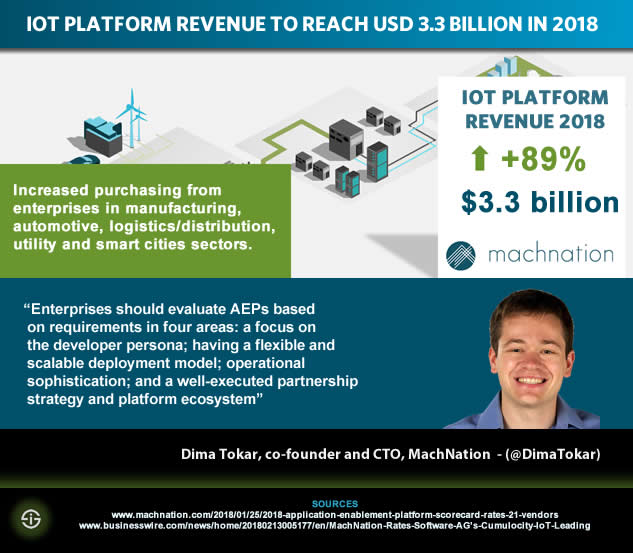
The MachNation Application Enablement Platform ScoreCard explained
Since the first editions of its Application Enablement Platform ScoreCard, MachNation classified vendors in 4 different categories: Application Enablement Platforms (AEPs), Platform Enabled Solutions (PESs), Specialized IoT Middleware (SIoTM) and Specialized Solution Providers (SSPs).
Vendors and platforms were plotted within a matrix with technology (from narrow focus to broad focus) and go-to-market (from solution-centric to technology-centric) as the two axis. Application Enablement Platforms have the broadest focus and most technology-centric approach and it’s here that leaders (such as Nokia Siemens Networks spin-of Cumulocity, now Software AG, and ClearBlade) were positioned.
MachNation defined an Application Enablement Platform as “a technology-centric offering optimized to deliver a best-of-breed, industry-agnostic, extensible middleware core for building a set of interconnected or independent IoT solutions for customers” as you can read in ClearBlade’s announcement from early 2017 (the matrix used can be seen in this PDF from Cumulocity IoT).
MachNation’s ScoreCard still contains several quadrants and matrices to help clarify a “muddy, yet booming platform ecosystem” as the company calls it. The Application Enablement Platform ScoreCard 2018 scored platforms across four categories of requirements: ‘develop’, ‘deploy’, ‘operate’ and ‘extend’.
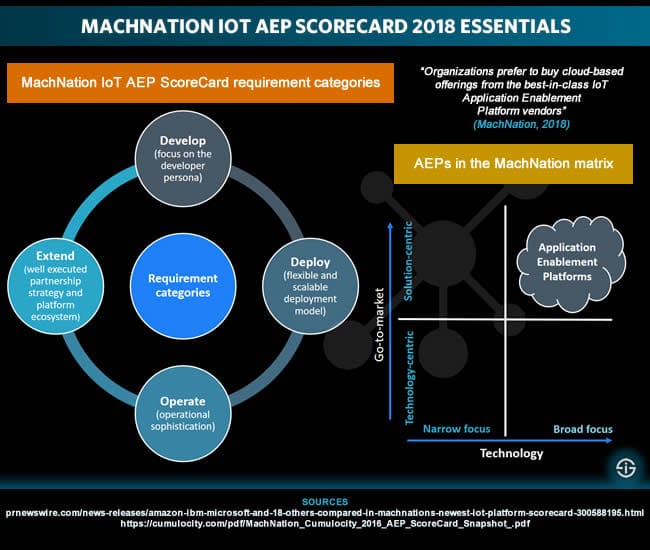
In 2018 Software AG’s Cumulocity again came out as a leader as the communication of the company clearly shows and as Bernd Gross, Senior VP of the Global IoT Unit for Software AG wrote in a blog post in February 2018, entitled ‘Cumulocity IoT Leads the AEP Pack for IoT‘. Quoting from Gross’s post: “Machnation, a pioneer of detailed independent technology assessments, has rated Software AG’s Cumulocity IoT platform as a leader ahead of 21 IoT vendors.”
The increasing role of the edge – comparing the MachNation AEP and IoT edge platform scorecards
Other vendors/platforms that have been communicating about their position as leaders include ClearBlade. You can download full version of the 2018 IoT Application Enablement Platform snapshot for ClearBlade here and for Cumulocity IoT here.
Obviously there are many parameters to take into account when selecting the IoT platform that best suits your needs, both from a business and technology perspective (with, as MachNation points out in the scope of application enablement a need to focus on usability and developers). In the context of technologies you can, for example, think about edge computing and fog computing. MachNation also has an IoT edge platform ScoreCard which we tackled previously in a post on how Industry 4.0 and Industrial IoT are boosting the IoT edge platform market.
In that ScoreCard Industrial Internet of Things platform Litmus Automation came out as a leader in both edge technology and edge strategy and was placed in the “market ready” quadrant as you can read here. However, here too you’ll find leaders such as Cumulocity IoT and ClearBlade with its ClearBlade IoT Edge Platform, on top of Litmus Automation’s Loop Edge, ADLINK’s Vortex Edge, CalAmp, Cisco Kinetic; Dell, Foghorn Systems, SAP, (Leonardo IoT Edge), Siemens MindSphere and Telit DeviceWISE to name a few.
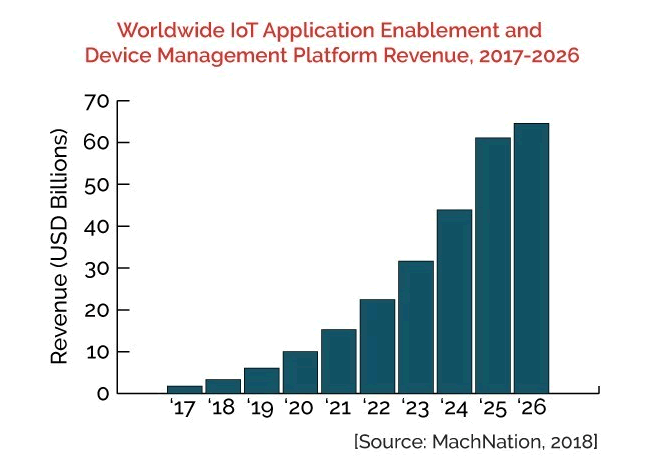
Several of the vendors in the MachNation 2018 Application Enablement Platform ScoreCard are known to be strong on the level of edge capabilities too of course. This doesn’t only go for players such as leader Cumulocity IoT but also for players such as relayr that, just like Foghorn systems, sits in the fog computing sphere.
So, it all depends on your needs and, increasingly, on your vertical industry and IoT use cases. There are smart city IoT platforms, platforms that are targeting sectors such as smart manufacturing as mentioned in a post on manufacturing platforms, those who are active in consumer markets, niches such as smart buildings, smart workplaces and smart homes, vendors with support for emerging technologies (e.g. blockchain in IoT, artificial intelligence and machine learning in IoT), the list goes on.
Application enablement platform benefits and selection criteria according to the MachNation AEP Scorecare
The scope of the MachNation IoT Application Enablement Platform ScoreCard, however, is to look at the big AEP players. And here, according to MachNation organizations prefer to buy cloud-based offerings from the best-in-class IoT Application Enablement Platform vendors (over building their own).
As MachNation’s Dima Tokar puts it in the mentioned announcement from Software AG on its Cumulocity IoT leader position, enterprises should evaluate AEPs based on requirements in four areas (tied to the earlier mentioned ‘develop’, ‘deploy’, ‘operate’ and ‘extend’ as you could see in the illustration):
- a focus on the developer persona;
- having a flexible and scalable deployment model;
- operational sophistication; and
- a well-executed partnership strategy and platform ecosystem
In the same press release, MachNation summarizes the benefits of application enablement platforms as a key IoT enabler and a critically important component in IoT deployments today whereby using an AEP
- leads to a faster time to market;
- ensures a high-quality, reliable, secure offering; and
- enables enterprises to build competitive advantage in their markets.
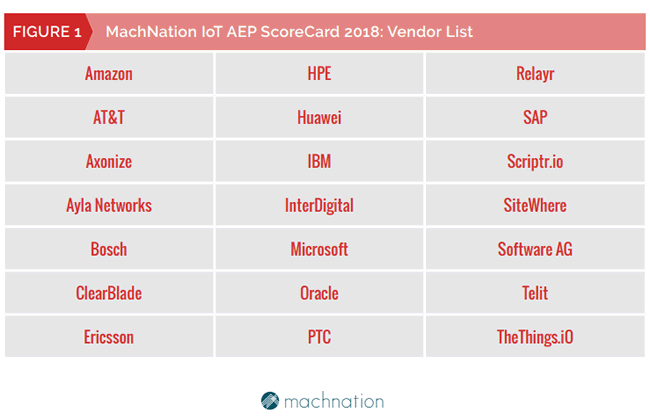
MachNation IoT platform market forecasts 2018 – 2026
These benefits obviously drive market demand, which brings us to the forecasts and predictions from MachNation regarding the IoT platform market. As mentioned, the company expects the market to reach USD3.3 billion in 2018, an impressive year-over-year growth of 89 percent according to the MachNation 2018 AEP platform scorecard press release.
MachNation sees increased purchasing from enterprises in manufacturing, automotive, logistics/distribution, utility and smart cities sectors. On the longer term MachNation expects the market to grow with a CAGR (Compound Annual Growth Rate) of 45 percent over the period until 2026 when the market is expected to reach USD 64.6 billion according to this March 2018 article on the Internet of Things Institute website where you can also download the Software AG Cumulocity IoT overview.
This growth of course has to do with the mentioned savings in time and money in creating an IoT solution. However, 2026 is still a long time away and by then the all by all still relatively young IoT platform market (whereby we mean the Application Enablement Platform market and not the classic M2M connectivity and device management platforms) will look entirely different with no doubt less players in an overcrowded market, more acquisitions (reminding us of good old dotcom period mantra ‘get big, get niche or get out’), more technologies and so forth.
And who knows by then the IoT solutions and technology landscape will be so interoperable, standardized, connected with or included in other applications, modular and easy to use for anything, ranging from device management to application enablement that we won’t even need application enablement platforms anymore. Although that is wishful dreaming.
As MachNation’s Samuel Hale puts it in the announcement of the MachNation IoT Application Enablement Platform ScoreCard for 2018: “Platform vendors all have similar marketing for their products. If you’re serious about understanding platform differences, you need to dig deeply into their products and capabilities. Our ScoreCard and MIT-E do that.”
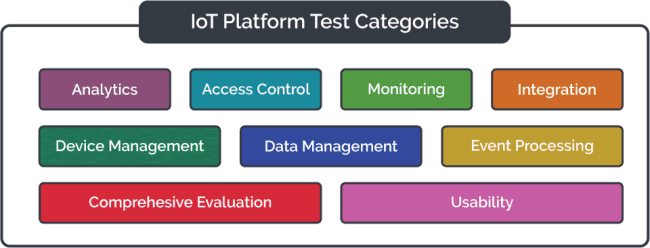
Selecting an IoT platform: MachNation’s MIT-E test and report
To conclude: as mentioned MachNation also has its MIT-E test platform and you can acquire the MIT‑E report, which compares IoT platforms, producing 1000s of data points rating 70+ developer and operator workflows, to support your choice of an IoT platform that suits you best.
Samuel Hale also pointed out three things that are missing from application enablement platforms in a February 2018 blog post on the MachNation site:
- a microservice-based, containerized architecture;
- an effective IoT marketplace;
- strong on-platform analytics capabilities
Happy reading and prosperous comparing and selecting!

